An organised and differentiated cellular structure having cytoplasm but no nucleus is called _________.
vessels
xylem parenchyma
sieve tubes
tracheids
Correct Answer :
C. sieve tubes
A mature sieve element possesses a peripheral cytoplasm and a large vacuole but lacks nucleus. Sieve tube consists of row of cells arranged one above the other to form long pipes. Sieve tube occurs in angeosperms. The functions of sieve tubes are controlled by the nucleus of companion cells.
Related Questions
Bast fibres are made up of _____________cells.
sclerenchymatous
chlorenchymatous
parenchymatous
aerenchymatous
Apical and intercalary meristems are primary meristems because
they occur in the mature region of roots and shoots of many plants.
they made up of different kinds of tissues.
they involved in secondary growth.
they appear early in life of a plant and contribute to the formation of the primary plant body.
Various functions like photosynthesis, storage, excretion performed by _____________.
sclerenchyma
parenchyma
collenchyma
aerenchyma
T.S. of dicot stem is given below, certain parts have been marked by alphabets (A I). Choose the option which shows their correct labelling.

A Epidermis, B Epidermal hair, C Parenchyma, D Starch sheath, E Hypodermis (collenchyma), F Vascular bundle, G Bundle cap, H Medulla or pith, I Medullary rays
A Epidermal hair, B Epidermis, C Hypodermis (collenchyma), D Parenchyma, E Endoderm is (Starch Sheath), F Pericycle, G Vascular bundle, H Medullary rays, I Medulla or pith
A Epidermal hair, B Epidermis, C Hypodermis (collenchyma), D Starch sheath, E Parenchyma, F Vascular bundle, G Bundle cap, H Medulla or pith, I Medullary rays
A Epidermal hair, B Epidermis, C Parenchyma, D Hypodermis (collenchyma), E Starch sheath, F Vascular bundle, G Bundle cap, H Medulla or pith, I Medullary rays
Tissue(s) present in an annual ring is/are
secondary xylem and phloem.
primary xylem and phloem.
secondary xylem only.
primary phloem and secondary xylem.
Which of the following statements is correct?
Lenticels occur in most woody trees.
Sclerenchymatous cells are usually present in cortex.
The vascular tissue system is divided into three main zones- cortex, pericycle and pith.
The conjoint vascular bundles usually have the xylem located only on the outer side of the phloem.
Tissues are classified into two main groups, namely meristematic and permanent tissues on the basis of
whether the cells being able to divide or not.
position of the cells.
whether they are living or dead.
none of the above
Which type of plant tissue is being described by the given statements?
- It consists of long, narrow cells with thick and lignified cell walls having a few or numerous pits.
- They are dead and without protoplasts.
- On the basis of variation in form, structure, origin and development, it may be either fibres or sclereids.
- It provides mechanical support to organs.
Parenchyma
Sclerenchyma
Collenchyma
Chlorenchyma
A tissue is a group of cells which are
similar in origin, but dissimilar in form and function.
dissimilar in origin, form and function.
dissimilar in origin, but similar in form and function.
similar in origin, form and function.
The given figure shows T.S. of monocot stem. Identify the correct labelling of A to F marked in the given figure.
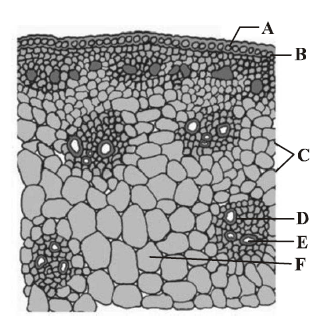
A Epidermis, B Hypodermis, C Vascular bundles, D Phloem, E Xylem, F Ground tissue
A Cuticle, B Epidermis, C Sclerenchymatous sheath, D Sclerenchymatous hypodermis, E Parenchymatous sheath, F Phloem
A Cuticle, B Epidermis, C Sclerenchymatous hypodermis, D Sclerenchymatous sheath, E Parenchymatous sheath, F Phloem
A Cuticle, B Epidermis, C Sclerenchymatous hypodermis, D Sclerenchymatous sheath, E Parenchymatous sheath, F Protoxylem
The given figure shows apical meristem of root apex with few part marked as A, B and C. Identify the correct labelling of A, B and C.
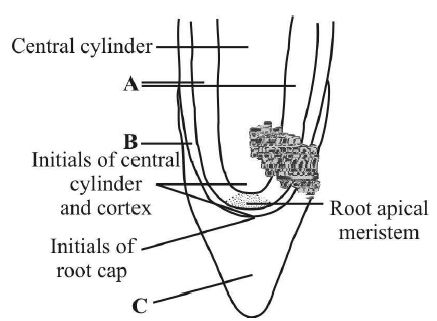
A Vascular structure, B Protoderm, C Root cap
A Cortex, B Endodermis, C Root cap
A Cortex, B Protoderm, C Root cap
A Tunica, B Protoderm, C Root cap
Cambium is considered as a lateral meristem because
it gives rise to lateral branches.
it causes increase in girth.
it increases height and diameter of a plant.
it adds bulk to a plant.
Which one of the followings option shows the correct labelling of the parts marked as A, B, C and D in the given figure a lenticel?
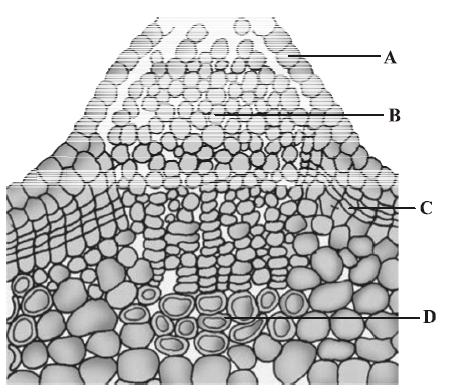
A Epidermis, B Secondary cortex, C Cork cambium, D Cork
A Pore, B Cork cambium, C Secondary cortex, D Cork
A Pore, B Cork, C Complimentary cells, D Cork cambium
A Epidermis, B Complimentary cells, C Cork cambium, D Secondary cortex
Match the elements of xylem given in column I with their character given in the column II and choose the correct option.
| Column-I | Column-II |
|---|---|
| A. Xylem vessels | I. Store food materials |
| B. Xylem tracheids | II. Obliterated lumen |
| C. Xylem fibres | III. Perforated plates |
| D. Xylem parenchyma | IV. Chisel-like ends |
A IV; B III; C II; D I
A III; B II; C I; D IV
A II; B I; C IV; D III
A III; B IV; C II; D I
The trees growing in desert will
show alternate rings of xylem and sclerenchyma.
have only conjunctive tissue and phloem is formed by the activity of cambium.
show distinct annual rings.
not show distinct annual rings.
Which one of the following statement is incorrect ?
- Epidermal cell has small amount of cytoplasm and a large vacuole.
- Waxy cuticle layer is absent in roots.
- Root hairs are unicellular, while stem hairs / trichomes are multicellular.
- Trichomes may be branched or unbranched, soft or stiff and prevent transpiration.
- Guard cells are dumbell shaped in dicots and beanshaped in monocots (e.g. grass).
Only (i)
Only (iv)
Only (iii)
Only (v)
The given diagrams show stomatal apparatus in dicots and monocots. Which one is correct option for A, B and C?

A Epidermal cells; B Subsidiary cells; C chloroplast
A Guard cells; B Subsidiary cells; C Stomatal pore
A Guard cells; B Epidermal cells; C Guard cells
A Epidermal cells; B Subsidiary cells; C Guard cells
Lignin is the important constituent in the cell wall of
phloem
parenchyma
xylem
cambium
The given figures are types of elements (A and B) which constitute one type of complex tissue (c) of a plant . Identify A, B and C.
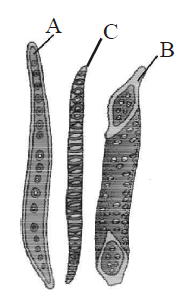
A Tracheid, B Vessel, C Xylem
A Vessel, B Tracheild, C Phloem
A Fibre, B Tracheid, C Bark
A Fibre, B Sclereid, C Casparian strips
Identify the types of simple tissue indicated by A, B, C and D and their function.
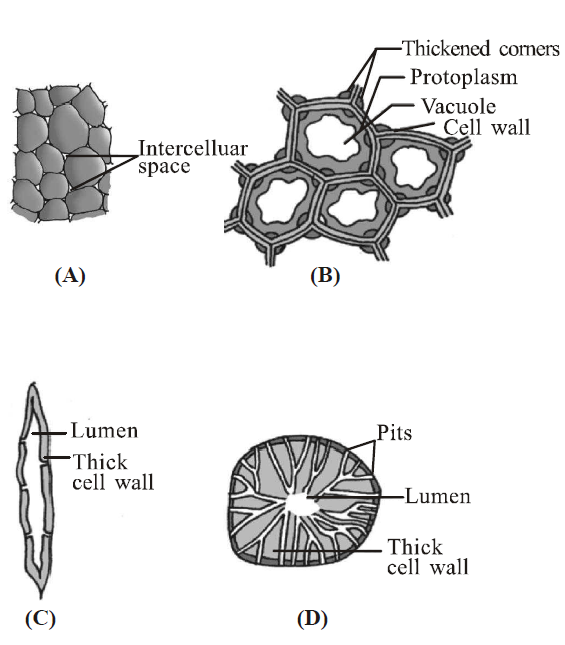
A Parenchyma, Photosynthesis, Storage and Secretion.
B Sclerenchyma Scleriods; Transport food material
C Collenchyma; Provides mechanical support to organs.
D Sclerenchyma Fibres; Provide Mechanical support to the growing parts of the plant such as young stem and petiole of a leaf.
Sieve tubes are suited for translocation of food because they possess
bordered pits.
no ends walls.
broader lumen and perforated cross walls.
no protoplasm.
Which of the following statement(s) is/are correct ?
- Uneven thickening of cell wall is characteristic of sclerenchyma.
- Periblem forms cortex of the stem and the root.
- Tracheids are the chief water transporting elements in gymnosperms.
- Companion cell is devoid of nucleus at maturity.
- The commercial cork is obtained from Quercus suber.
(i) and (iv) only
(ii) and (v) only
(iii) and (iv) only
(ii), (iii) and (v) only
In an experiment, a student cut a transverse section of young stem of a plant which he has taken from his school garden.
After observing it under the microscope how would he ascertain whether it is a monocot stem or a dicot stem?
With the help of bulliform cells.
With the help of casparian strips.
With the help of vascular bundles.
With the help of stomatal apparatus.
Read the following statements and answer the question.
- It has a sclerenchymatous hypodermis, a large number of scattered vascular bundles and a large parenchymatous ground tissue.
- Vascular bundles are conjoint and closed.
- Peripheral vascular bundles are generally smaller than the centrally located ones.
- Phloem parenchyma is absent, and water- containing cavities are present within the vascular bundles.
Which plant anatomy is being described by the above statements?
Dicotyledonous root
Monocotyledonous root
Dicotyledonous stem
Monocotyledonous stem
Which meristem helps in increasing girth?
Lateral meristem
Intercalary meristem
Primary meristem
Apical meristem
Why grafting is successful in dicots ?
In dicots vascular bundles are arranged in a ring.
Dicots have cambium for secondary growth.
In dicots vessels with elements are arranged end to end.
Cork cambium is present in dicots
A plant tissue when stained showed the presence of hemicellulose and pectin in cells wall of its cells. The tissue is called
collenchyma
sclerenchyma
xylem
meristem
The given figure shows the secondary growth in a dicot stem. Their parts are marked as A, B, C, D, E & F. Choose the correct labelling of the parts marked as A to F.

A Phellem, B Phellogen, C Medullary rays, D Secondary xylem, E Secondary phloem, F Cambium ring
A Phellem, B Phellogen, C Medullary rays, D Secondary phloem, E Secondary xylem, F Cambium ring
A Phellogen, B Phellem, C Medullary rays, D Secondary xylem, E Secondary phloem, F Cambium ring
A Phellem, B Phellogen, C Cambium ring, D Secondary xylem, E Secondary phloem, F Medullary rays
Which of the following statement(s) is/are not correct?
- Cork cambium is also called phellogen.
- Cork is also called phellem.
- Secondary cortex is also called periderm.
- Cork cambium, cork and secondary cortex are collectively called phelloderm.
(iii) and (iv)
(i) and (ii)
(ii) and (iii)
(ii) and (iv)
Some vascular bundles are described as open because these
are surrounded by pericycle but not endodermis.
are capable of producing secondary xylem and phloem.
possess conjunctive tissue between xylem and phloem.
are not surrounded by pericycle.
